Romania
Our school is situated in the north-west part of Romania, in the city of Oradea. 69 teachers and 19 non-teaching staff are working and teaching in 3 buildings, one of them situated in the rural area of Bihor county (Episcopia Bihor). On 2 levels-primary and secondary level- we house 822 Ss from the preparatory through the 8th form, and they continue in the 9th form with the passing of a "leaving" exam. They are tested in Romanian and Hungarian language and Maths.Last year we introduced the Chess Palace optional discipline in 4 of our classes as a result of our ongoing Erasmus project. We want to build a safe and supportive school climate for EACH child, to develop open-minded attitudes towards the world and we also guide Ss towards their future careers according to their own potential. We do our best to integrate children with different disabilities into the group: 8 orphans, 32 students with bad financial condition, 23 Ss with special needs and a number of 114 Ss with learning disabilities and low academic marks.
With this project we want to find a solution to the threats we identified 2 years ago: an increasing number of Ss with parents working abroad, Ss who live with grandparents/relatives.Their emotional drop-down can be felt in the class atmosphere, they are not accepted by their peers. With this project we want to help their inclusion, we wish to provide them attractive learning environment by engaging them in craft-related activities.
Our Ts noticed the benefits of Arts and Crafts activities on Ss-they open themselves, cooperate, they accept each other. Having more and more craft related activities we can invest in building their cognitive, physical, and social development and also HELP in boosting their academic performance.
Meeting European peers and trying crafts that started disappearing, we support Ss in the process of a conscious and independent choice of the next
stage of education. Tooling, team working and problem-solving are cross-disciplinary skills, and learning disappearing crafts can offer a good job
opportunity for our pupils in the future.
C1- Romania
27-29 Sptember 2021
On the 1st day of the Short term joint-staff training event for teachers held in Oradea, Romania, a number of 14 classes together with their teachers prepared different activities where the showed our guests the way they create little masterpieces with their own hands during the Arts and Crafts activities. They also showed us some really interesting activities that people used to do in the past and their teachers taught them lessons about these and at the moment of this LTT there already were some handicrafts they could prepare on their own.
Examples of the activities: corn shelling, cheese making, pottery plate painting, wood painting, weaving, making shell shaped pasta, preparing gingerbread and decorating it, also horse whipping, bread baking in the oven, husk doll making, glass painting, rope weaving, and they also presented popular songs and traditional games used to play by children some centuries ago.
The participants from all the countries had the opportunity to engage into some of the listed activities and competitions were organized, too (for example who could shell a maize corn quicker). Students, teachers and participants enjoyed the activities.The restaurant we had dinner is a place full of old symbolism, the owner explained our guests the meaning of each furniture drawing/symbol and also stories were told about these pieces of furniture or potteries.
On the 2nd day the partner members travelled to 3 villages in the rural district of Bihor county where we could meet a craftsman who is a blacksmith and he presented the way he is working into his workhouse. We visited an old agricultural exhibition, where we could get to know about the old devices people used and at the restaurants where we had lunch and dinner, we could see exhibitions of old crafts such as potteries, painted furniture, etc. We had the opportunity to experience the way a pottery is made this was a wonderful and exciting experience for all of us.
On the 3rd day we travelled to Biharia village to a farm of the Darabont family where we could try hand-harvesting and the whole team. It was a wonderful, useful, exciting experience for all of us.
https://photos.google.com/share/AF1QipM7w4npmuFS5WjcZxxBD3H758ttfZYBfhgmeuc6XBeAp9y0jU3DoM3wfgBA72n2Iw?key=YVdKNE5GSi1KV0YxelgzSHA5bTVtSUQtd0tuaDNn
C2- Poland-virtual LTT
14-18 March 2022
On Monday, 14th of March the host school organized the opening ceremony virtually, too, Polish films were presented. Greece had a Loom weaving activity, Cyprus - working with clay, Slovakia - sewing
Romania - Kahoot game about Romania and Romanian crafts but also wood painting activity with second graders.
On the 15th of March Greece prepared an exhibition of their products, Cyprus worked with mosaics, Slovakia made embroidery workshop, Romania prepared Easter dessert with students, using traditional egg painting techniques and onsite the visited folk workshops – madder making – marzanna and also had a workshop in the museum of bread. Teachers and students participated in the Zoom meetings organized for the day, showing their work and products.
On the 16th of March Slovakia -was weaving with the students, Cyprus was making traditional honey pies, Greece creative Votive offerings and Romania had bread making activity with the students. In the meantime Poland and Italy had a guided tour in The Wieliczka Salt Mine and a short sightseeing walk in Cracow.
On the 17th of March Greece made Traditional pasta, Cyprus made traditional dumplings, Slovakia was modeling and Romania organized egg painting with their students. In the meantime Poland and Italy were making dumplings – workshop at the school canteen and Aspen basket workshop in Osikowa Dolina.
On the 18th of March each country had their students play games on the topic, during Zoom time they presented their products. Also interviews with a craftsman was made by each country and also other short videos or powerpont presentations were prepared for the participants.
As if it was a virtual activity, there were many students and teachers involved in each country, they had the opportunity to work guided by their teachers and create products they were so proud at the end of the LTT.
The speakers were on playing folk music sung by students from each country and everybody had fun learning about their culture! During the first Zoom meeting we had the opportunity to watch a beekeeper and learn a lot about this profession, while during the second Zoom meeting, everybody expressed their thanks to the Polish team for organizing the activity and said farewell to all partners.
C3- Cyprus LTT
16-20 May 2022
6 students and 2 teachers from 4 partner schools and also 3 teachers from Greece met in Cyprus (Greece did not accept student mobility) in order to participate at any of the at this LTT student activities.
We originally planned that Cyprus would involve 20 students and 10 teachers but in real they involved 20 teachers and 155 students. Each day different students and teachers engaged in the activities. The methodology used was workshops, visits to museums/craftsman workshops.
The Deputy Minister of Tourism, two school inspectors, the community council president, members of the School Parents Association Board, the principal of the kindergarten and two primary school principals welcomed us.
-Students with their teachers participated in four workshops in the school yard: traditional dances, mosaics, traditional games and engraving pumpkins. Erasmus students were shown the way to create little masterpieces by their own hands during the Arts and Crafts activities.
-We visited the UNESCO protected Ayios Nikolaos tis Steyis church and we were amazed by the frescos. Then we travelled to the village of Galata where we walked through the Museum of Folk Art which was created with donations of items from the houses of the villagers. There, we could get to know about the old devices people used, traditional object, traditional costumes, as well as the silk making machine among others. Nearby village of Evrychou, students had a pottery workshop. They used old Cypriot clay pots as an inspiration to create clay miniature vases to take back to their own country. At Spilia village we had a hand-on experience, helping a villager prepare the traditional siousioukkos and ppalouze, followed by a visit to a shoemaker’s museum and a monastery.
-In Nicosia we visited the Cyprus Handicraft Service. There partners passed by different workshops as embroidery (Lefkara lace), weaving in traditional looms, wood carving, pottery, basketry and silk artwork. Then, students participated in a workshop with cocoon embroidery. In this workshop, they achieved a tangible result, a concrete product of their active learning, as they created a bookmark with cocoon embroidery. Students had the opportunity to write anti-war messages on paper doves and stick them to a wall by the checkpoint in the centre of Nicosia to promote peace.
-A teacher session was also organized concerned on project tasks and future plans.
We mostly served traditional Cypriot food and it was a way for guests to experience Cypriot culture and Cypriot cuisine.
-A farewell party with live traditional dances was organized and certificates of participation were given.
Participants were given samples of presented material (e.g. documents, artifacts), which they could show their own colleagues upon returning home in order to generate interest in similar projects.
We planned to organise activities in all partner schools for students to try and create artifacts both at school and their homes.
C3- Slovakia
13-17 February 2023
6 Ss and 2 Ts participate from 4 countries and also 3 Ts from Greece as Greece does not take students in mobilities. Slovakia involved 85 students and 25 teachers, much more than they initially planned.
Methodology used was MODULE 4- Workshops, visits to museums/craftsman workshops, cultural element and also eTwinning platform.
I have to mention here that all Slovakian students were rroma students and all activities were focused upon working with SEN rroma students who, as we could witness, really have difficults social and economic backgrounds.
Mgr. Jozef Besterci, director of the United Boarding School, and Ing. Ján Kokarda, the mayor of Ždaňa welcomed delegates from 5 partner schools at the House of Culture. Students in cooperation with the pupils from the elementary school in Čaňa, prepared an artistic performance/Slovak dance, songs, folk costumes. By so doing host partner introduced their traditional cultural wealth to the partners.
Participants could participate at workshops presenting traditional crafts of Ždaňa region. Pupils tried working with the clay, weaving on a loom, painting on the wood, macrame, paper knitting, creating an angel from ribbons (kanzashi technique), sewing scented hearts and decorating textiles. Pupils, teachers and participants appreciated a lot the activities and they took their hand-made products to their home countries.
As part of the art therapy, we visited the world-famous Roma Theater Romathan where we could hear and see an exceptional concert called "Forgotten Roma Melodies". It represented ancient Roma melodies, folk dances and songs that are transmitted from generation to generation. Host partners wanted to underline how important the identity of a nation is and how it can be preserved by folk music for next generations.
Participants could see two presentations of Slovak hand-made crafts, sticky lace and wood carving, at the Kindergarten in Bukovec.
Chopstick lace is certainly a gem of Slovak folk art. These laces were characterized by precision and delicacy and are still famous all over the world today. Students had the opportunity to try this unique craft by their own.
Wood carving - wood was the most available and widespread material in the past. Artistic wood carving opens a new life dimension for the material. During the carving the carver molds his idea into the wood using chisels. The pupils were fascinated by working with wood. We could also discover Slovak folk ensemble - Čarnica ensemble. Folk songs and dances, which are an integral part of Slovak culture and country, became an art-therapeutic experience. The folk assemble not only prepared a beautiful performance, but also taught the students to dance basic steps and together they sang the Slovak folk song "A ja taká čarna". Later, they knitted a traditional Easter willow - which is symbol of the Easter.
We completed feedback forms at the end and received our certificates during a ceremonial farewell party.
C6- Italy
18-20 April 2023
The aim of it was to increase number of useful methods to help our teachers work with disadvantaged students. Italy is a wonderful learning environment. Ts shared share experiences and analysed good practices from all the activities already organized within the project.
The target group of the activity included 3 teachers/partner school (1 primary school teacher, 1 craft T and 1 support T who works with children who encounter different learning/behavioral issues), a total of 15 Ts and also 11 teachers from the Italian school. The methodology used was MODULE 6- Workshops, visits to museums/craftsman workshops, cultural element but also laboratory. In the Italian school there was the possibility to organize activities that gave direct experience and opportunity to make a comparison with different cultures, favors and increases the educational offer, ensuring our users a more complete and extensive training that encourages the study and knowledge of what is not usually found in books.The host institution provided a tour of the old crafts present in the city of
Palermo. Ithe partners were accompanied to various workshops organized by the school, including a ceramics decoration workshop, a mosaic-making workshop, and a workshop on creating typical Sicilian baskets. Passing through one of Palermo's most famous markets, "Il Capo" (named after a district in the city of Palermo), the partners were taken to a restaurant for lunch where they could experience the typical flavors of Sicilian cuisine. In the afternoon, we visited the "Museo Pitrè" in Palermo, an ethnographic museum where several tools and utensils used in ancient crafts are preserved. Partners were taken to Mr. Michele Ducato's workshop, one of the last Sicilian cart painters in the Palermo area, where they participated in decorating a ceramic plate with one of the recurring themes in
cart painting. The ancient crafts presented to the partners sparked interest in Italian and Sicilian culture, and the painting of the cart motif on the ceramic plate using the method presented by Mr. Ducato was considered useful to be replicated in the partner countries' schools. The objective of integration between teachers from partner organizations and students from the host school was also achieved, as pupils considered the mobility as a great opportunity to come into contact with different cultures and perspectives.
C5- Greece
15-19 May 2023
On Day 1 we participated in two workshops: the making of shadow puppets and engraving on Styrofoam. After that, we tasted traditional snacks and delicacies prepared by parents and then we went to mountain Imittos where we walked on nature trails. Our Erasmus plus team adopted one of these trails and now everyone can see a small plaquette saying ‘Erasmus plus’.
Then the 5 delegations went to the park of Kaisariani called ‘Shooting Range of Kaisariani’ where they learnt the history of the Freedom Monument which honours all the Greek people who gave their lives for our freedom in the 2nd World War. After that we walked through Kaisariani, saw some of the historic buildings and ended our stroll at the restaurant where our guests tasted Greek cuisine.
On Day 2, we started with a coach tour around the historic centre of Athens. We saw Omonia Square, the oldest square of the city, the Parliament and the Changing of the Guards, Syntagma Square and Kalimarmaro Stadium where the first modern Olympic Games were held. Then we visited a ceramics workshop where the partner students learnt about the Art of Ceramics in ancient Athens and they themselves created their own works of art. Then we went to the Hill of the Acropolis where we had a guided tour around the hill. The delegations had the opportunity to see the Parthenon and learn about this renowned monument and then it was time to visit the Acropolis Museum and see famous artefacts of the ancient world.
On Day 3 we visited a worry beads workshop where the students learnt about this old craft and then we went to Tolo, at a seaside restaurant where our guests tasted Greek cuisine. After lunch our visitors had integrating activities by the beach, before returning to Athens.
On Day 4 we set off towards the Marathon. We saw the Marathon Tomb, learnt its history and the origins of the Marathon Race. Then we visited the archaeological Museum of Marathonas and then we went to the area Varnavas where we visited the European Museum of Decorative Bread and attended a workshop in which our guests learnt the history of bread and the various types of bread made in Greece. They saw how bread was decorated for different occasions, they made ‘goglies’- a type of traditional pasta. In the evening we had our farewell dinner.
On Day 5, we went to ‘Tholos’, a virtual theatre of the cultural centre ‘Hellenic World’ and watched a virtual interactive performance about the Ancient ‘Agora’-Market.
We all agreed that the host organization organized activities related to the theme of the project and that our partners enriched their knowledge in ancient Greek Crafts as well as their understanding of modern Greece. It was also agreed that after the trip to Greece partners should organize in their schools activities related to crafts they experienced in Greece. Participants completed a questionnaire to get detailed feedback of this LTT.























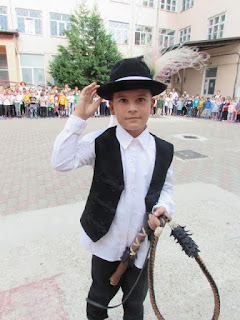











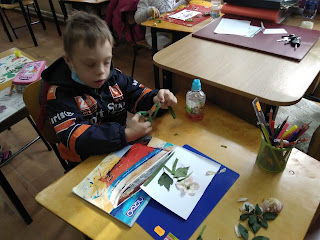
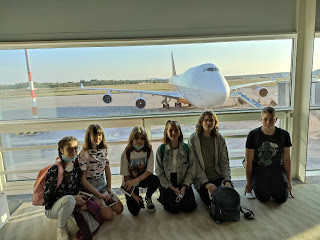
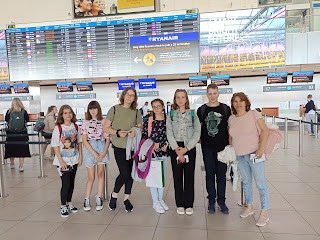
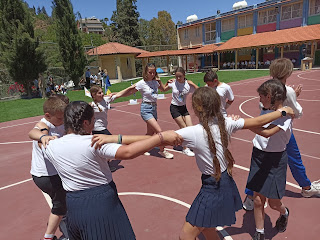



























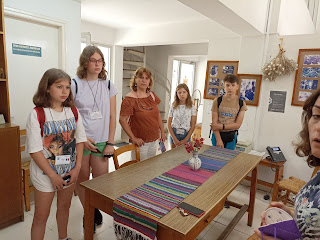






















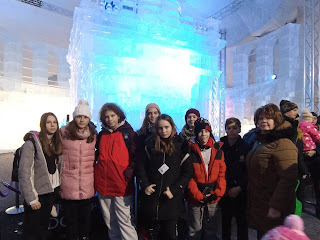


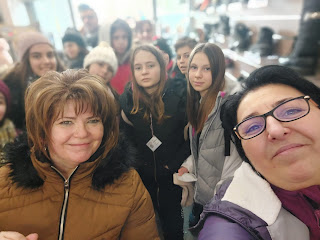









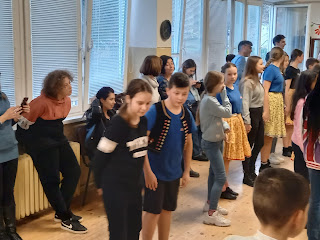











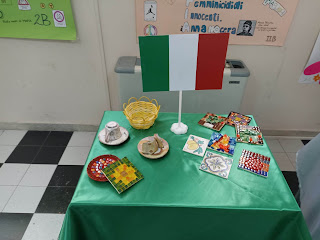




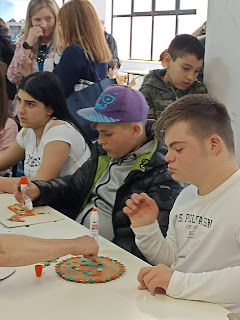

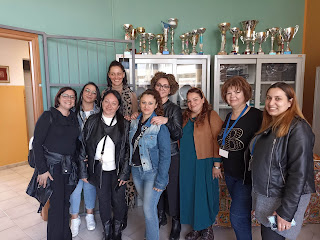

















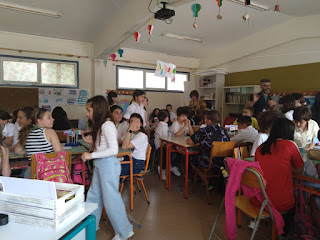







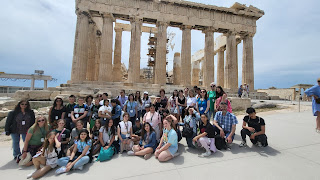
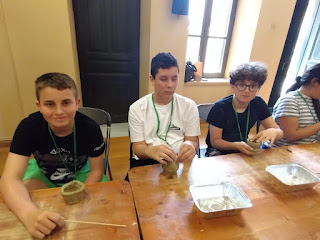


















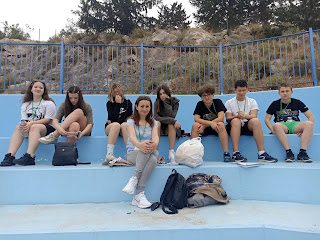
Comments
Post a Comment